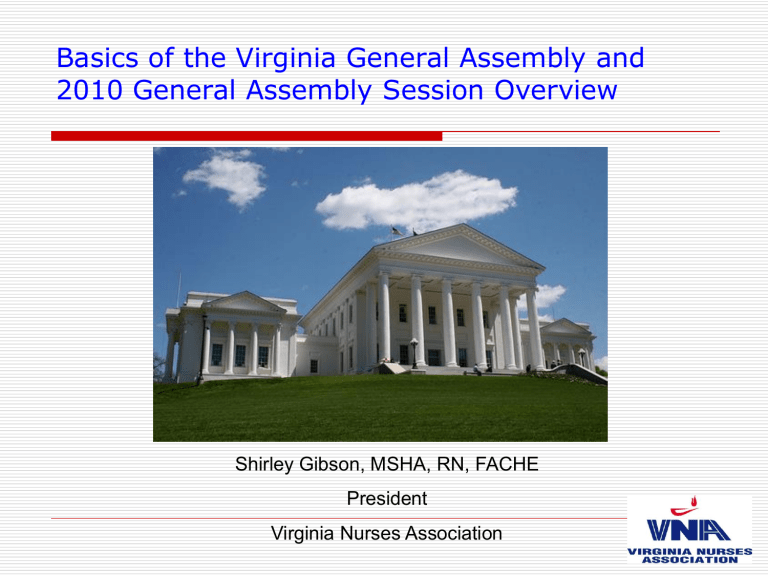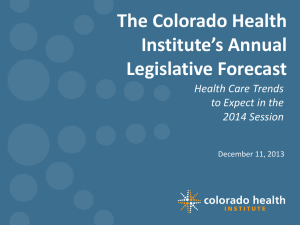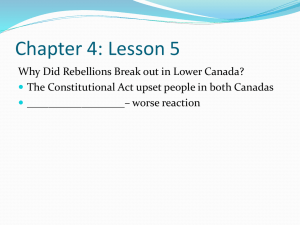Basics of the Virginia General Assembly and 2010 General

Basics of the Virginia General Assembly and
2010 General Assembly Session Overview
Shirley Gibson, MSHA, RN, FACHE
President
Virginia Nurses Association
OBJECTIVES
To understand the Virginia General
Assembly Structure
To understand the General Assembly
Session
To review 2010 Legislation
To discuss 2011 Legislation and
Emerging Issues
Virginia House of Delegates
Consists of 100 members referred to as “Delegates”:
Each Delegate represents 71,000 citizens
Delegates are elected for two year terms
There are no term limits
The Speaker of the House is the presiding officer
Annual salary is $17,640
59 Republicans
39 Democrats
2 Independents
Senate of Virginia
Consists of 40 members referred to as “Senators”:
Each Senator represents 176,000 citizens
Senators serve four year terms
There are no term limits
The Lieutenant Governor is the presiding officer
Annual salary is $18,000
22 Democrats
18 Republicans
The Lieutenant Governor votes only in the case of a tie
State-Wide Offices
Office of the Governor
Current Governor is Bob McDonnell (R)
The Governor serves a four year term
The Governor cannot serve consecutive terms
Virginia’s Governor wields immense power
Controls the Cabinet
Controls most state agencies
Has almost total regulatory control
Crafts the state’s budget
State-Wide Offices, cont’d .
Office of the Lieutenant Governor
Current Lt. Governor is Bill Bolling (R)
The Lt. Governor serves a four year term
The Lt. Governor can serve consecutive terms
This is Lt. Governor Bolling’s second term
The Lt. Governor presides over the Senate of Virginia
Assumes the place of the Governor in the event of the Governor’s death or inability to continue in office
State-Wide Offices, cont’d .
Office of the Attorney General
The current Attorney General is Ken Cuccinelli (R)
The AG provides legal advice and representation to the
Governor, executive agencies, state boards, commissions, and institutions of higher education
Provides written legal advice in the form of official opinions to members of the General Assembly and government officials
Defends the constitutionality of state laws when they are challenged in court
How a Bill Becomes Law
Bills start as ideas
These ideas come from:
Legislators
Special Interest Groups
Constituents
These ideas are submitted to “Legislative Services” by:
Delegates
Senators
The Governor
How a Bill Becomes Law, cont’d
Legislative Services “drafts” the bill and then:
The bill is signed by the “patron”
The signed bill is submitted to the Clerk of the House or the Clerk of the Senate
The Clerk submits the bill to the Speaker of the
House or the President Pro Tempore of the Senate
The Speaker or President Pro Tempore assign the bill to a “committee”
How a Bill Becomes Law, cont’d
The Committee Process
Committees are broken down by subject area
Committees are further split into subcommittees
Once the sub-committee acts on a bill it is sent to full committee
If a bill fails in sub-committee it will usually fail in full committee or not be heard at all
If a bill passes sub-committee it will usually pass full committee
The above two points are not always true
If a bill fails in full committee it is usually “dead”
How a Bill Becomes Law, cont’d
The Committee Process, cont’d
If the bill passes full committee it goes to the floor of the House or Senate
Passing to the “Floor”
Bills coming from committees are placed on the
“calendar”
Bills are “read” three times
The first reading is introductory
The second reading is for debate with a vote to move it to third reading
The third reading is for passage with a vote to move it to the other body where the committee process begins again
There are subtle differences in the way the House and the
Senate follow the above process
2010 Legislation
VNA tracked a total of 53 pieces of legislation
Sample Legislation:
HB 253 Registered and practical nurses; licensure qualifications.
Patroned by Delegate Merricks
VNA opposed
Would have allowed certain military training and service to substitute for the formal nursing education requirement.
Patron agreed to “carry over” so that VNA could work with him after session.
2010 Legislation, cont’d
Sample Legislation, cont’d:
HB 189 Immunizations; philosophical exemption
Patroned by Delegate Purkey
VNA opposed
Would have allowed for parents to opt out of immunization requirements due to philosophical reasons
Bill died in sub-committee
HB 1168 Health professionals; instruction on pain management and addiction
Patroned by Delegate Bud Phillips
VNA opposed
Would have required the schools of nursing to include instruction in pain management and addiction.
Bill died in sub-committee
2010 Legislation, cont’d
Sample Legislation, cont’d:
HJ 133 Mammograms, yearly; Health
Commissioner to promote as an effective tool in breast cancer prevention.
Patroned by Delegate McQuinn
VNA supported
Requests the State Health Commissioner to promote and emphasize yearly mammograms as an effective tool in breast cancer prevention
Requires the State Health Commissioner to submit an executive summary and report of the progress in meeting the request of this resolution to the 2011 Regular Session of the General Assembly.
Has been passed by the House and the Senate.
Budget Basics
Virginia has a “biennial” budget
The budget covers two “fiscal years”
The fiscal year begins on July 1 st
The budget is adopted in even numbered years
A “caboose” budget is produced every year
The caboose budget makes modifications to the preceding fiscal year
The Governor crafts the initial budget
Since Virginia’s Governor may not serve consecutive terms, every four years a budget is crafted by a
Governor who will not be in office while the budget is debated and passed
Budget Basics, cont’d
The Governor crafts the initial budget
Budgets are based on “estimated revenue”
House Appropriations and Senate Finance amend the
“Governor’s budget”
After the above is done, the Governor’s budget disappears and is replaced by two budgets. These are known as the “House budget” and the “Senate budget”
The two budgets are presented to their respective chambers, amended, and passed to the other body
Budget Basics, cont’d
Each chamber invariably rejects the others’ budget
This places the two budgets into a “Committee of
Conference”
Conferees are appointed by the leadership of the House of Delegates and the Senate (Usually six from each.)
The job of the conferees is to take the two budgets and meld them into one
The budget conference is a mystical process
No one but the conferees really understands what happens there
Budget Basics, cont’d
Once the conferees have finished their work, each chamber approves the new budget
New budgets take effect on July 1 st , which is the start of the new fiscal year
Difficulties in Reconciling the House and
Senate Budgets
What took so long?
How much money do we actually have to spend?
Fee increases
Health care vs. Public Education
Enhanced FMAP funding from the Federal Government
Public Safety vs. Public Education
Do we adjourn session without a budget?
Under this scenario, session would adjourn on time
Conferees would continue to work
Once conferees were in agreement session would be reconvened and the budget passed
Health and Human Services Budget
Outcome, cont’d
Medicaid Provider Payment Changes General
Fund
Most Restored with FMAP
Hospital Inpatient Payments ($14,609,580) ($24,164,264)
Hospital Capital Payments ($1,609,968) ($2,649,535)
Hospital Outpatient Payments ($6,928,731) ($10,802,339)
Indigent Care Payments to Teaching Hospitals ($7,100,000)
($7,100,000)
Modify IME Payments to Out of State Hospitals
($1,695,182) ($1,917,627)
Reciprocal Payments to Out of State Hospitals ($2,253,621)
($2,965,290)
Health and Human Services Budget
Outcome, cont’d.
Medicaid Provider Payment Changes General Fund
(cont’d.)
Most Restored with FMAP
Nursing Home Payments ($11,940,294) ($13,819,962)
Nursing Home Capital Payments ($995,659) ($2,514,099)
Physician & Other Practitioner Services ($8,777,395)
($14,714,275)
Dental Services ($1,473,404) ($2,333,840)
Therapeutic Day Treatment Services ($1,494,140) ($2,253,605)
Psychiatric Residential Treatment Facilities ($1,321,092)
($1,985,800)
Pharmacy Dispensing Fee from $3.75 to $3.50 FY 12 ($,523,579)
Auxiliary Grant Payment for Assisted Lvg. Fac. FY 12 ($2,413,152)
The Problem with FMAP
Congress hasn’t authorized the enhanced
FMAP funding
Republicans killed it in the Senate
Democrats killed it in the House
The states are not happy
On July 1 st Virginia will implement 360 million in cuts to health care.
Most states will cut much more.
The Senate says it is working on passing a bill authorizing enhanced FMAP funding.
Emerging Issues for 2011
Title Protection for Nurses maybe inclusive of SW and Physicians –
Delegate Peace
RN Circulator in OR – Ambulatory and
Hospitals – Delegate Garrett
Clinical hours for nursing education
Virginia Health Reform Initiative
Advisory Council
Nurse Practitioner scope of practice
VHRI Advisory Council
VNA President Shirley Gibson serves
Workgroups:
1. Medicaid Reform
2. Insurance Market Reform
3. Delivery and Payment Reform
4. Capacity (Co-Chair)
5. Technology
6. Purchasers Perspective
Conference Calls every other Monday
Nurse Practitioner Scope of Practice
Likely to emerge as a key recommendation from the VHRI
Medically underserved areas
Nurse managed clinics
Compromise language that will not be opposed by major constituency groups
Due by end of calendar year
Nursing Education Issues
Capacity
One in four faculty to retire in next five years
Clinical hours for schools of nursing
Certification, competency, and CE
Grass Roots: Be your own lobbyist
Get to know your legislator!
Building a relationship is worth its weight in gold
During session is not the best time to do this
Legislators love having someone with area expertise they can call on
You have two things legislators need:
Expertise
Votes
Grass Roots: Be your own lobbyist, cont’d.
Building the relationship
In office visits after session
Invite legislators to your workplace
Invite legislators to your professional meetings
VNA is glad to help – join public policy email list!
Grass Roots: Be your own lobbyist, cont’d
Knowledge is power; online resources:
Who's my legislator?
(Use the link on the GA main page)
General Assembly main page
(http://legis.virginia.gov)
All the information you could ever want
(http://leg1.state.va.us)
Follow the money (www.vpap.org)
2010 Mid-Term Elections
What Happened Nationally?
Republicans gained control of the House
Republicans made gains in the Senate
Republicans gained control of numerous state legislatures and governorships
What Happened in Virginia?
3 democratic incumbents lost their seats
2 of these (Perriello and Nye) were one term incumbents
1 (Boucher) was a 28 year incumbent
2010 Mid-Term Elections, cont’d
Why is it important?
Effectively destroys the President’s ability to set a successful agenda
Puts national health care reform in serious and certain jeopardy
Republicans will control redistricting in several key swing states
26
th










